Developing Consultancy Skills Report: CIPD Module 5CNS
VerifiedAdded on 2023/04/04
|21
|4823
|444
Report
AI Summary
This report delves into the realm of consultancy skills, specifically within the context of Learning and Development (L&D). It begins by defining consultancy and exploring various models, including the process consultation model, which emphasizes client ownership and joint diagnosis. The report then compares and contrasts different types of consultancies, such as advisory and operational consultants, and examines the seven stages of the consultancy process, from discovery and analysis to implementation and follow-up. A significant portion of the report focuses on how to establish the requirements for an L&D solution with a client, emphasizing the need to analyze performance issues and move beyond generic training solutions. Furthermore, the report discusses how to assess potential solutions, recommend costed L&D solutions, and support clients during the implementation phase, including reporting on progress and recommending future actions to ensure sustainable change. The report is structured around the CIPD module 5CNS, with activities addressing the different learning outcomes, and provides practical insights into the consultancy process, client engagement, and solution development in an L&D setting. The report is a comprehensive guide for L&D professionals looking to develop their consultancy skills.
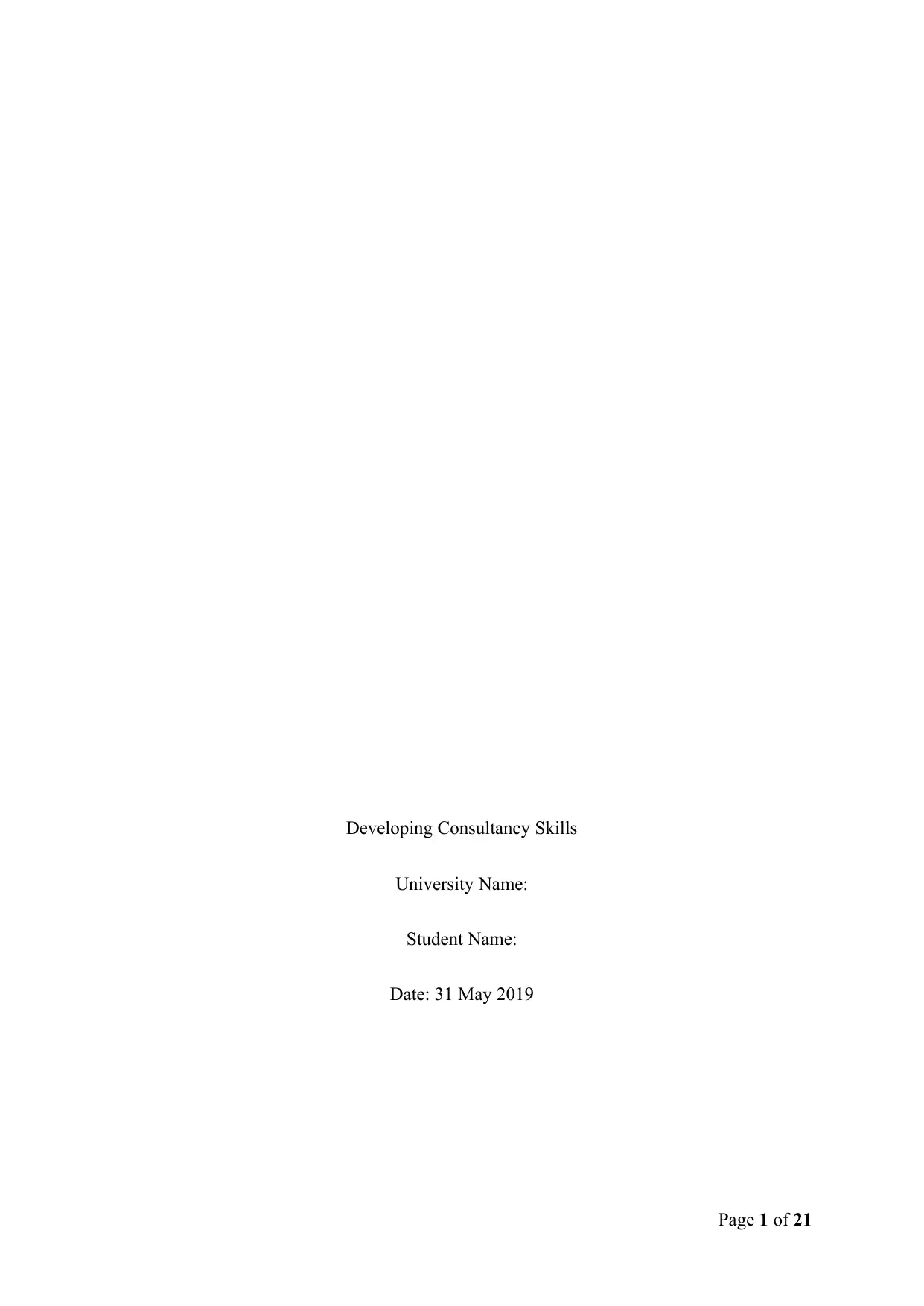
Developing Consultancy Skills
University Name:
Student Name:
Date: 31 May 2019
Page 1 of 21
University Name:
Student Name:
Date: 31 May 2019
Page 1 of 21
Paraphrase This Document
Need a fresh take? Get an instant paraphrase of this document with our AI Paraphraser
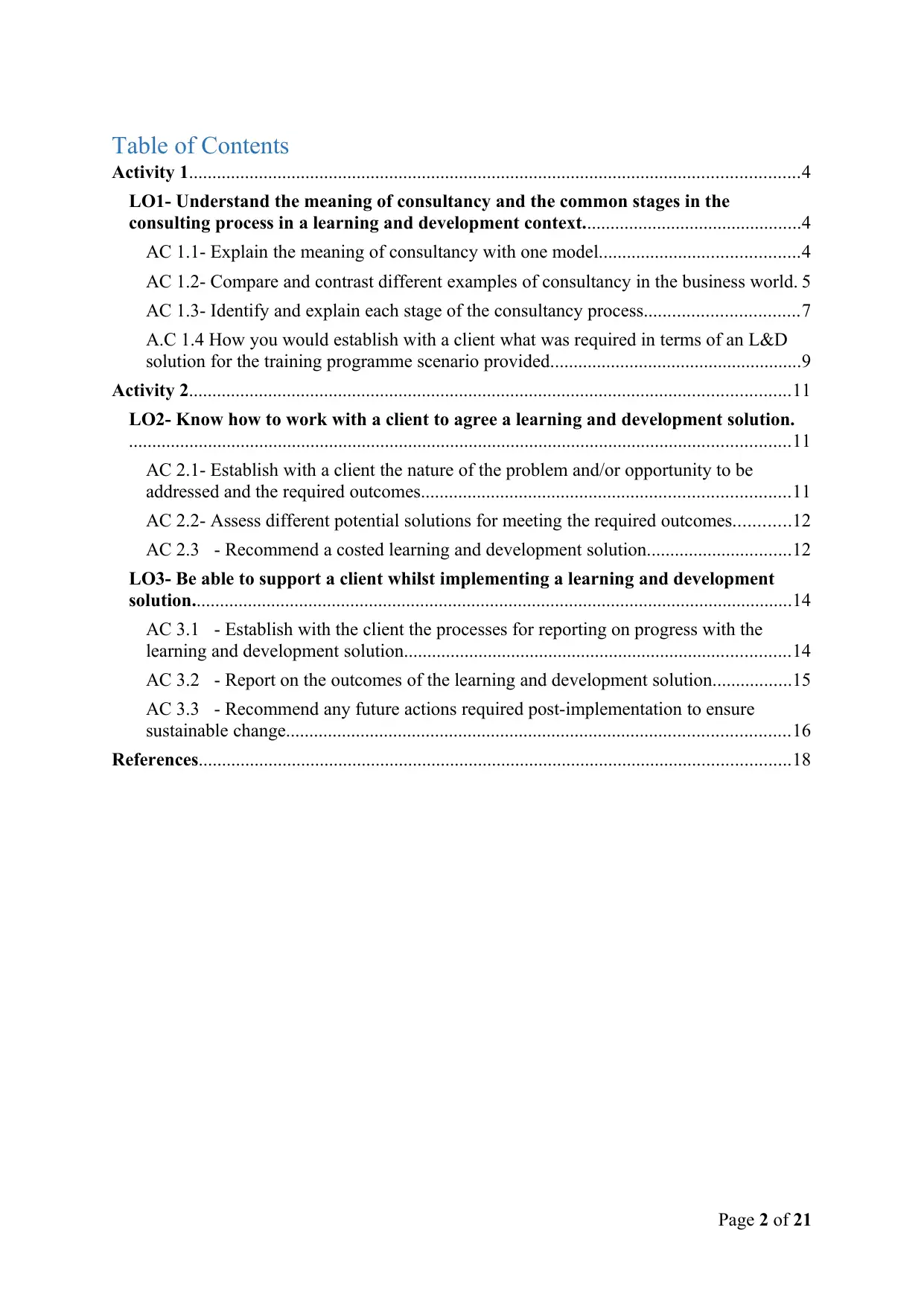
Table of Contents
Activity 1...................................................................................................................................4
LO1- Understand the meaning of consultancy and the common stages in the
consulting process in a learning and development context...............................................4
AC 1.1- Explain the meaning of consultancy with one model...........................................4
AC 1.2- Compare and contrast different examples of consultancy in the business world. 5
AC 1.3- Identify and explain each stage of the consultancy process.................................7
A.C 1.4 How you would establish with a client what was required in terms of an L&D
solution for the training programme scenario provided......................................................9
Activity 2.................................................................................................................................11
LO2- Know how to work with a client to agree a learning and development solution.
..............................................................................................................................................11
AC 2.1- Establish with a client the nature of the problem and/or opportunity to be
addressed and the required outcomes...............................................................................11
AC 2.2- Assess different potential solutions for meeting the required outcomes............12
AC 2.3 - Recommend a costed learning and development solution...............................12
LO3- Be able to support a client whilst implementing a learning and development
solution.................................................................................................................................14
AC 3.1 - Establish with the client the processes for reporting on progress with the
learning and development solution...................................................................................14
AC 3.2 - Report on the outcomes of the learning and development solution.................15
AC 3.3 - Recommend any future actions required post-implementation to ensure
sustainable change............................................................................................................16
References...............................................................................................................................18
Page 2 of 21
Activity 1...................................................................................................................................4
LO1- Understand the meaning of consultancy and the common stages in the
consulting process in a learning and development context...............................................4
AC 1.1- Explain the meaning of consultancy with one model...........................................4
AC 1.2- Compare and contrast different examples of consultancy in the business world. 5
AC 1.3- Identify and explain each stage of the consultancy process.................................7
A.C 1.4 How you would establish with a client what was required in terms of an L&D
solution for the training programme scenario provided......................................................9
Activity 2.................................................................................................................................11
LO2- Know how to work with a client to agree a learning and development solution.
..............................................................................................................................................11
AC 2.1- Establish with a client the nature of the problem and/or opportunity to be
addressed and the required outcomes...............................................................................11
AC 2.2- Assess different potential solutions for meeting the required outcomes............12
AC 2.3 - Recommend a costed learning and development solution...............................12
LO3- Be able to support a client whilst implementing a learning and development
solution.................................................................................................................................14
AC 3.1 - Establish with the client the processes for reporting on progress with the
learning and development solution...................................................................................14
AC 3.2 - Report on the outcomes of the learning and development solution.................15
AC 3.3 - Recommend any future actions required post-implementation to ensure
sustainable change............................................................................................................16
References...............................................................................................................................18
Page 2 of 21
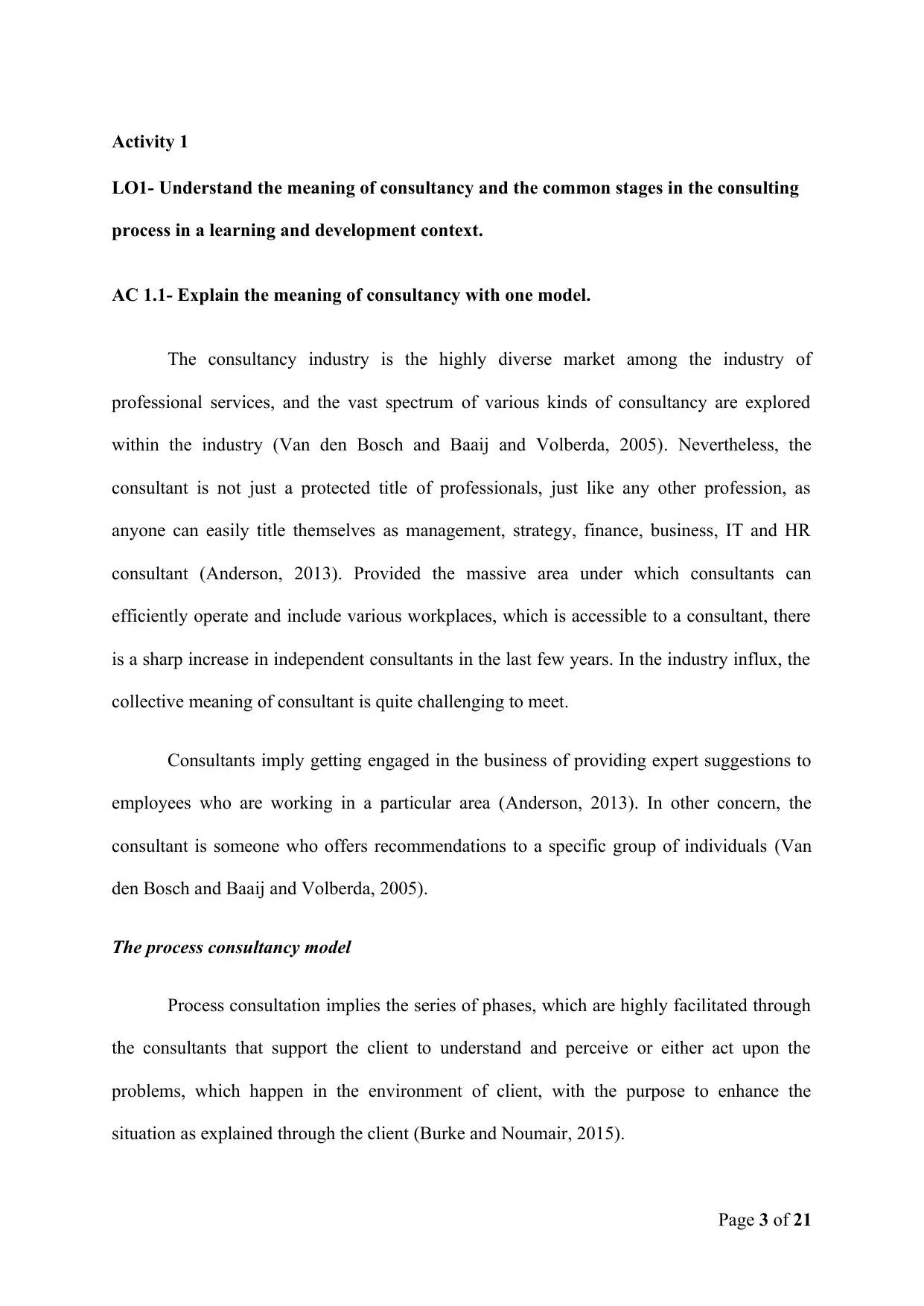
Activity 1
LO1- Understand the meaning of consultancy and the common stages in the consulting
process in a learning and development context.
AC 1.1- Explain the meaning of consultancy with one model.
The consultancy industry is the highly diverse market among the industry of
professional services, and the vast spectrum of various kinds of consultancy are explored
within the industry (Van den Bosch and Baaij and Volberda, 2005). Nevertheless, the
consultant is not just a protected title of professionals, just like any other profession, as
anyone can easily title themselves as management, strategy, finance, business, IT and HR
consultant (Anderson, 2013). Provided the massive area under which consultants can
efficiently operate and include various workplaces, which is accessible to a consultant, there
is a sharp increase in independent consultants in the last few years. In the industry influx, the
collective meaning of consultant is quite challenging to meet.
Consultants imply getting engaged in the business of providing expert suggestions to
employees who are working in a particular area (Anderson, 2013). In other concern, the
consultant is someone who offers recommendations to a specific group of individuals (Van
den Bosch and Baaij and Volberda, 2005).
The process consultancy model
Process consultation implies the series of phases, which are highly facilitated through
the consultants that support the client to understand and perceive or either act upon the
problems, which happen in the environment of client, with the purpose to enhance the
situation as explained through the client (Burke and Noumair, 2015).
Page 3 of 21
LO1- Understand the meaning of consultancy and the common stages in the consulting
process in a learning and development context.
AC 1.1- Explain the meaning of consultancy with one model.
The consultancy industry is the highly diverse market among the industry of
professional services, and the vast spectrum of various kinds of consultancy are explored
within the industry (Van den Bosch and Baaij and Volberda, 2005). Nevertheless, the
consultant is not just a protected title of professionals, just like any other profession, as
anyone can easily title themselves as management, strategy, finance, business, IT and HR
consultant (Anderson, 2013). Provided the massive area under which consultants can
efficiently operate and include various workplaces, which is accessible to a consultant, there
is a sharp increase in independent consultants in the last few years. In the industry influx, the
collective meaning of consultant is quite challenging to meet.
Consultants imply getting engaged in the business of providing expert suggestions to
employees who are working in a particular area (Anderson, 2013). In other concern, the
consultant is someone who offers recommendations to a specific group of individuals (Van
den Bosch and Baaij and Volberda, 2005).
The process consultancy model
Process consultation implies the series of phases, which are highly facilitated through
the consultants that support the client to understand and perceive or either act upon the
problems, which happen in the environment of client, with the purpose to enhance the
situation as explained through the client (Burke and Noumair, 2015).
Page 3 of 21
⊘ This is a preview!⊘
Do you want full access?
Subscribe today to unlock all pages.

Trusted by 1+ million students worldwide
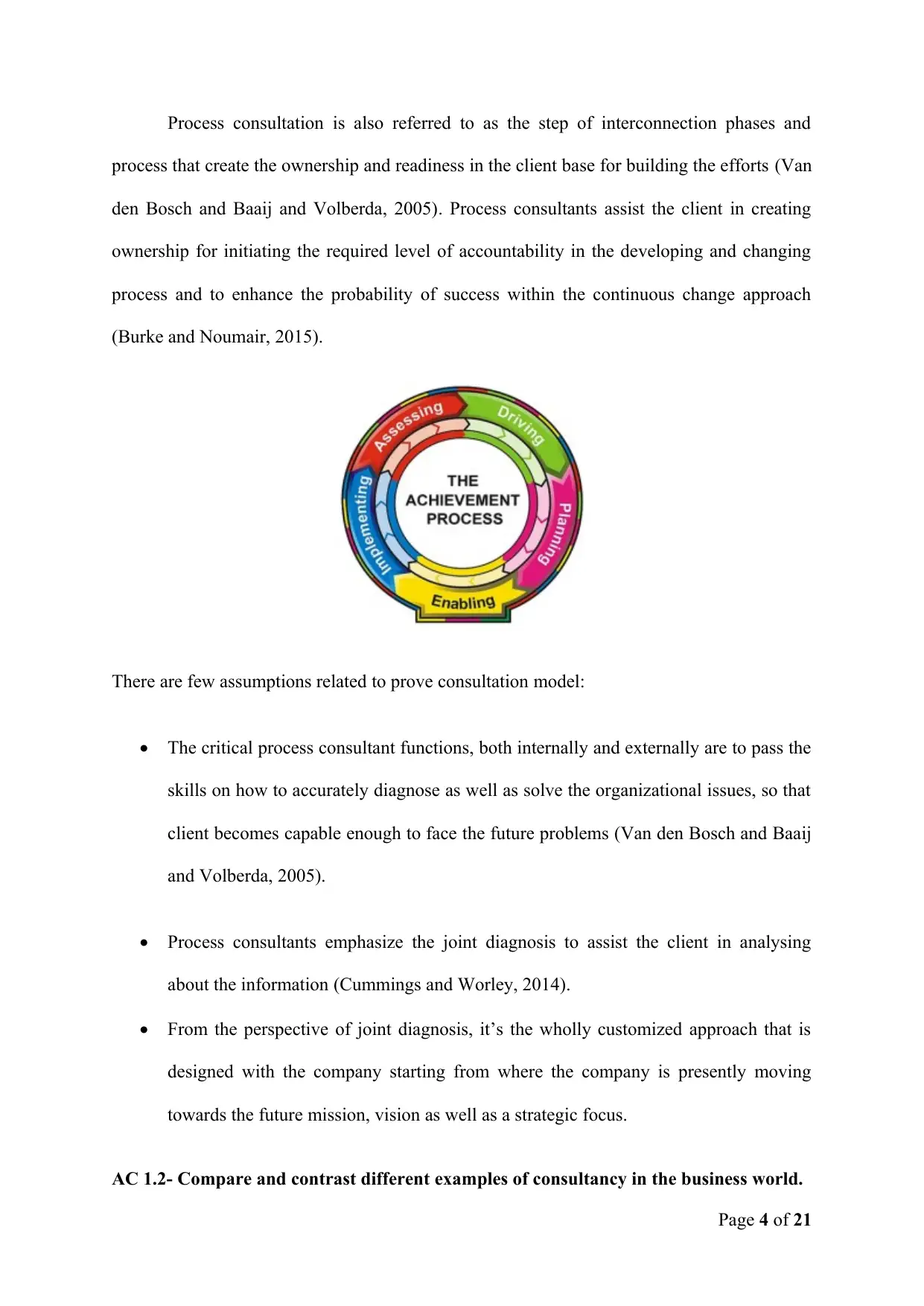
Process consultation is also referred to as the step of interconnection phases and
process that create the ownership and readiness in the client base for building the efforts (Van
den Bosch and Baaij and Volberda, 2005). Process consultants assist the client in creating
ownership for initiating the required level of accountability in the developing and changing
process and to enhance the probability of success within the continuous change approach
(Burke and Noumair, 2015).
There are few assumptions related to prove consultation model:
The critical process consultant functions, both internally and externally are to pass the
skills on how to accurately diagnose as well as solve the organizational issues, so that
client becomes capable enough to face the future problems (Van den Bosch and Baaij
and Volberda, 2005).
Process consultants emphasize the joint diagnosis to assist the client in analysing
about the information (Cummings and Worley, 2014).
From the perspective of joint diagnosis, it’s the wholly customized approach that is
designed with the company starting from where the company is presently moving
towards the future mission, vision as well as a strategic focus.
AC 1.2- Compare and contrast different examples of consultancy in the business world.
Page 4 of 21
process that create the ownership and readiness in the client base for building the efforts (Van
den Bosch and Baaij and Volberda, 2005). Process consultants assist the client in creating
ownership for initiating the required level of accountability in the developing and changing
process and to enhance the probability of success within the continuous change approach
(Burke and Noumair, 2015).
There are few assumptions related to prove consultation model:
The critical process consultant functions, both internally and externally are to pass the
skills on how to accurately diagnose as well as solve the organizational issues, so that
client becomes capable enough to face the future problems (Van den Bosch and Baaij
and Volberda, 2005).
Process consultants emphasize the joint diagnosis to assist the client in analysing
about the information (Cummings and Worley, 2014).
From the perspective of joint diagnosis, it’s the wholly customized approach that is
designed with the company starting from where the company is presently moving
towards the future mission, vision as well as a strategic focus.
AC 1.2- Compare and contrast different examples of consultancy in the business world.
Page 4 of 21
Paraphrase This Document
Need a fresh take? Get an instant paraphrase of this document with our AI Paraphraser
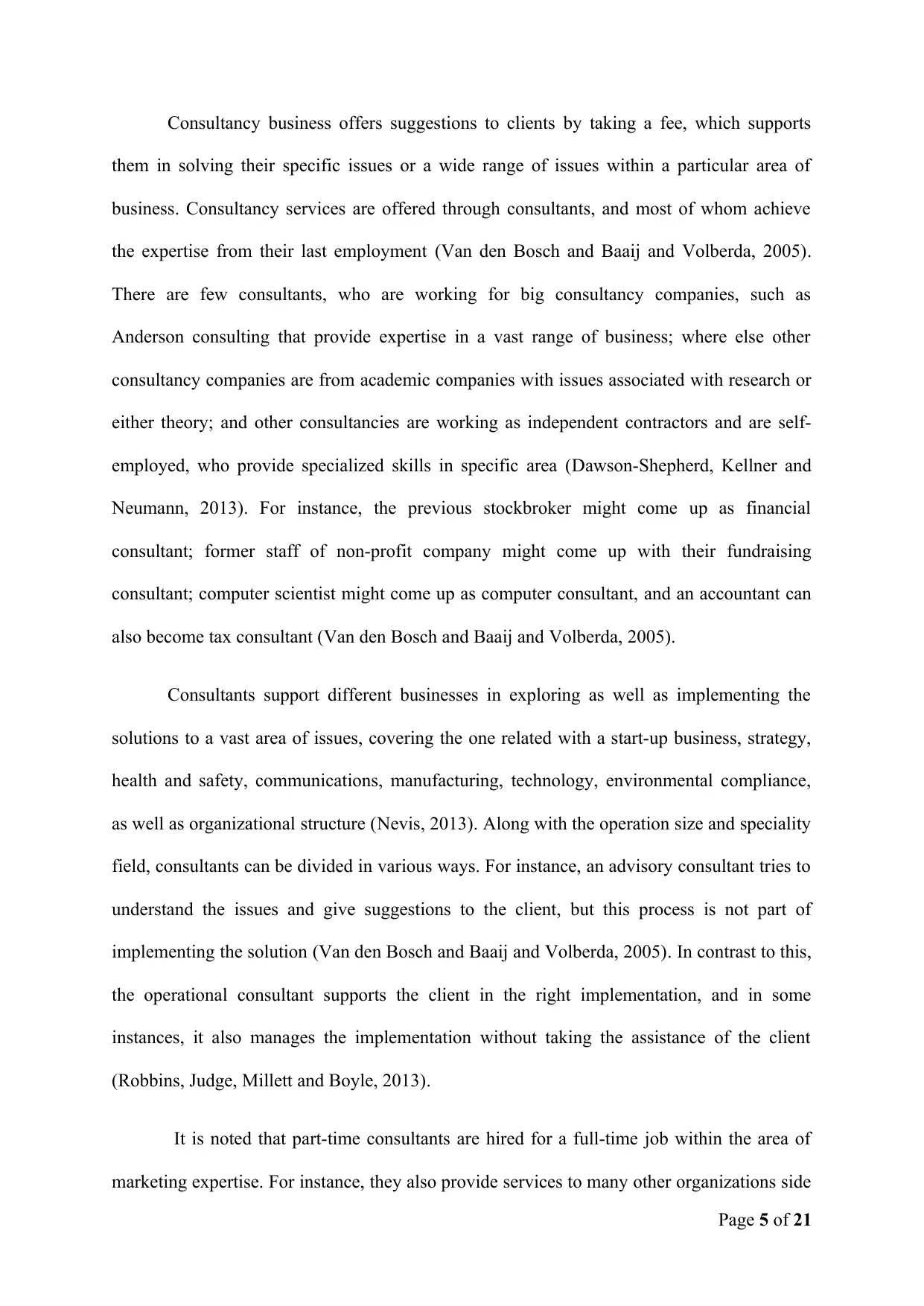
Consultancy business offers suggestions to clients by taking a fee, which supports
them in solving their specific issues or a wide range of issues within a particular area of
business. Consultancy services are offered through consultants, and most of whom achieve
the expertise from their last employment (Van den Bosch and Baaij and Volberda, 2005).
There are few consultants, who are working for big consultancy companies, such as
Anderson consulting that provide expertise in a vast range of business; where else other
consultancy companies are from academic companies with issues associated with research or
either theory; and other consultancies are working as independent contractors and are self-
employed, who provide specialized skills in specific area (Dawson-Shepherd, Kellner and
Neumann, 2013). For instance, the previous stockbroker might come up as financial
consultant; former staff of non-profit company might come up with their fundraising
consultant; computer scientist might come up as computer consultant, and an accountant can
also become tax consultant (Van den Bosch and Baaij and Volberda, 2005).
Consultants support different businesses in exploring as well as implementing the
solutions to a vast area of issues, covering the one related with a start-up business, strategy,
health and safety, communications, manufacturing, technology, environmental compliance,
as well as organizational structure (Nevis, 2013). Along with the operation size and speciality
field, consultants can be divided in various ways. For instance, an advisory consultant tries to
understand the issues and give suggestions to the client, but this process is not part of
implementing the solution (Van den Bosch and Baaij and Volberda, 2005). In contrast to this,
the operational consultant supports the client in the right implementation, and in some
instances, it also manages the implementation without taking the assistance of the client
(Robbins, Judge, Millett and Boyle, 2013).
It is noted that part-time consultants are hired for a full-time job within the area of
marketing expertise. For instance, they also provide services to many other organizations side
Page 5 of 21
them in solving their specific issues or a wide range of issues within a particular area of
business. Consultancy services are offered through consultants, and most of whom achieve
the expertise from their last employment (Van den Bosch and Baaij and Volberda, 2005).
There are few consultants, who are working for big consultancy companies, such as
Anderson consulting that provide expertise in a vast range of business; where else other
consultancy companies are from academic companies with issues associated with research or
either theory; and other consultancies are working as independent contractors and are self-
employed, who provide specialized skills in specific area (Dawson-Shepherd, Kellner and
Neumann, 2013). For instance, the previous stockbroker might come up as financial
consultant; former staff of non-profit company might come up with their fundraising
consultant; computer scientist might come up as computer consultant, and an accountant can
also become tax consultant (Van den Bosch and Baaij and Volberda, 2005).
Consultants support different businesses in exploring as well as implementing the
solutions to a vast area of issues, covering the one related with a start-up business, strategy,
health and safety, communications, manufacturing, technology, environmental compliance,
as well as organizational structure (Nevis, 2013). Along with the operation size and speciality
field, consultants can be divided in various ways. For instance, an advisory consultant tries to
understand the issues and give suggestions to the client, but this process is not part of
implementing the solution (Van den Bosch and Baaij and Volberda, 2005). In contrast to this,
the operational consultant supports the client in the right implementation, and in some
instances, it also manages the implementation without taking the assistance of the client
(Robbins, Judge, Millett and Boyle, 2013).
It is noted that part-time consultants are hired for a full-time job within the area of
marketing expertise. For instance, they also provide services to many other organizations side
Page 5 of 21
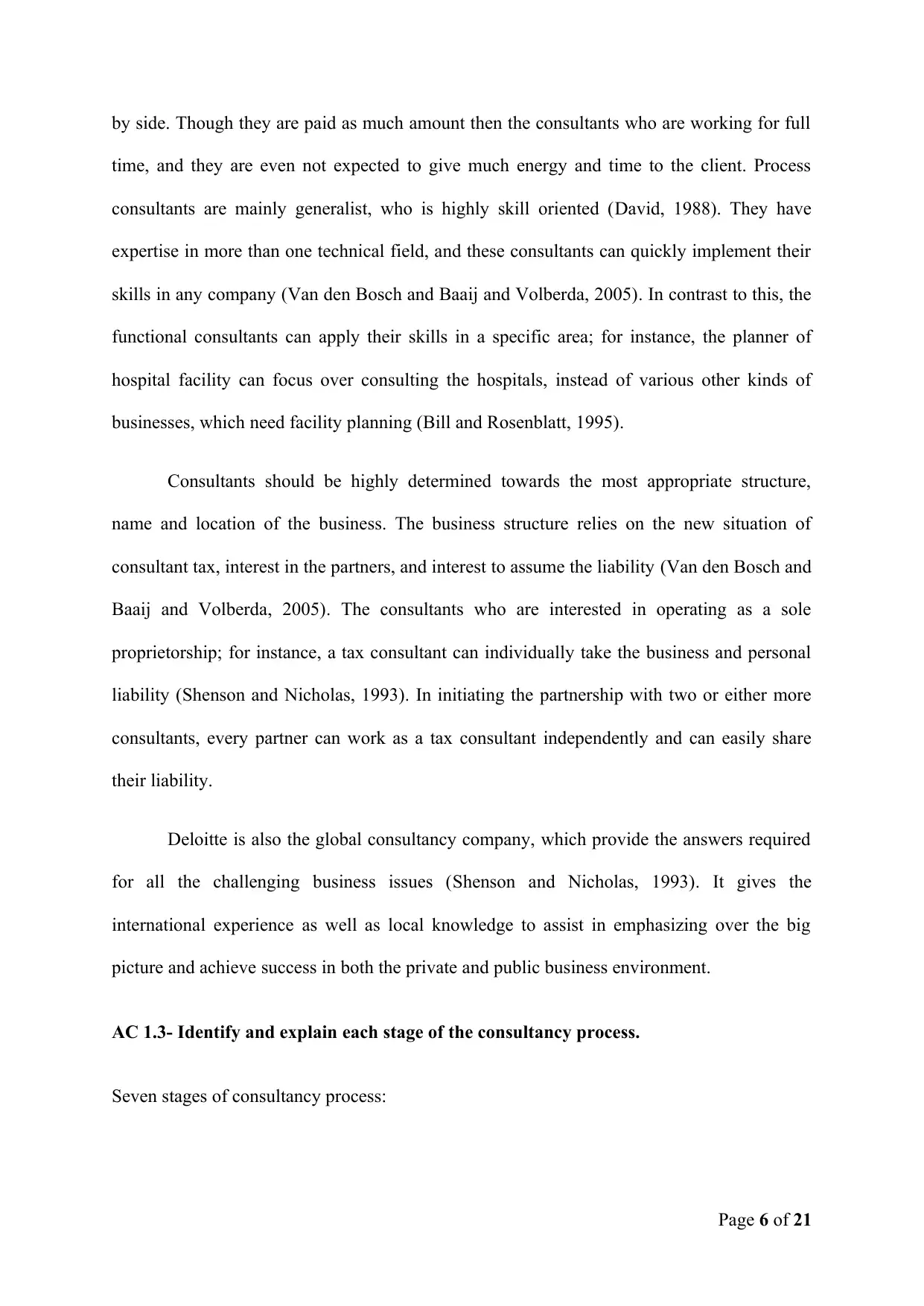
by side. Though they are paid as much amount then the consultants who are working for full
time, and they are even not expected to give much energy and time to the client. Process
consultants are mainly generalist, who is highly skill oriented (David, 1988). They have
expertise in more than one technical field, and these consultants can quickly implement their
skills in any company (Van den Bosch and Baaij and Volberda, 2005). In contrast to this, the
functional consultants can apply their skills in a specific area; for instance, the planner of
hospital facility can focus over consulting the hospitals, instead of various other kinds of
businesses, which need facility planning (Bill and Rosenblatt, 1995).
Consultants should be highly determined towards the most appropriate structure,
name and location of the business. The business structure relies on the new situation of
consultant tax, interest in the partners, and interest to assume the liability (Van den Bosch and
Baaij and Volberda, 2005). The consultants who are interested in operating as a sole
proprietorship; for instance, a tax consultant can individually take the business and personal
liability (Shenson and Nicholas, 1993). In initiating the partnership with two or either more
consultants, every partner can work as a tax consultant independently and can easily share
their liability.
Deloitte is also the global consultancy company, which provide the answers required
for all the challenging business issues (Shenson and Nicholas, 1993). It gives the
international experience as well as local knowledge to assist in emphasizing over the big
picture and achieve success in both the private and public business environment.
AC 1.3- Identify and explain each stage of the consultancy process.
Seven stages of consultancy process:
Page 6 of 21
time, and they are even not expected to give much energy and time to the client. Process
consultants are mainly generalist, who is highly skill oriented (David, 1988). They have
expertise in more than one technical field, and these consultants can quickly implement their
skills in any company (Van den Bosch and Baaij and Volberda, 2005). In contrast to this, the
functional consultants can apply their skills in a specific area; for instance, the planner of
hospital facility can focus over consulting the hospitals, instead of various other kinds of
businesses, which need facility planning (Bill and Rosenblatt, 1995).
Consultants should be highly determined towards the most appropriate structure,
name and location of the business. The business structure relies on the new situation of
consultant tax, interest in the partners, and interest to assume the liability (Van den Bosch and
Baaij and Volberda, 2005). The consultants who are interested in operating as a sole
proprietorship; for instance, a tax consultant can individually take the business and personal
liability (Shenson and Nicholas, 1993). In initiating the partnership with two or either more
consultants, every partner can work as a tax consultant independently and can easily share
their liability.
Deloitte is also the global consultancy company, which provide the answers required
for all the challenging business issues (Shenson and Nicholas, 1993). It gives the
international experience as well as local knowledge to assist in emphasizing over the big
picture and achieve success in both the private and public business environment.
AC 1.3- Identify and explain each stage of the consultancy process.
Seven stages of consultancy process:
Page 6 of 21
⊘ This is a preview!⊘
Do you want full access?
Subscribe today to unlock all pages.

Trusted by 1+ million students worldwide
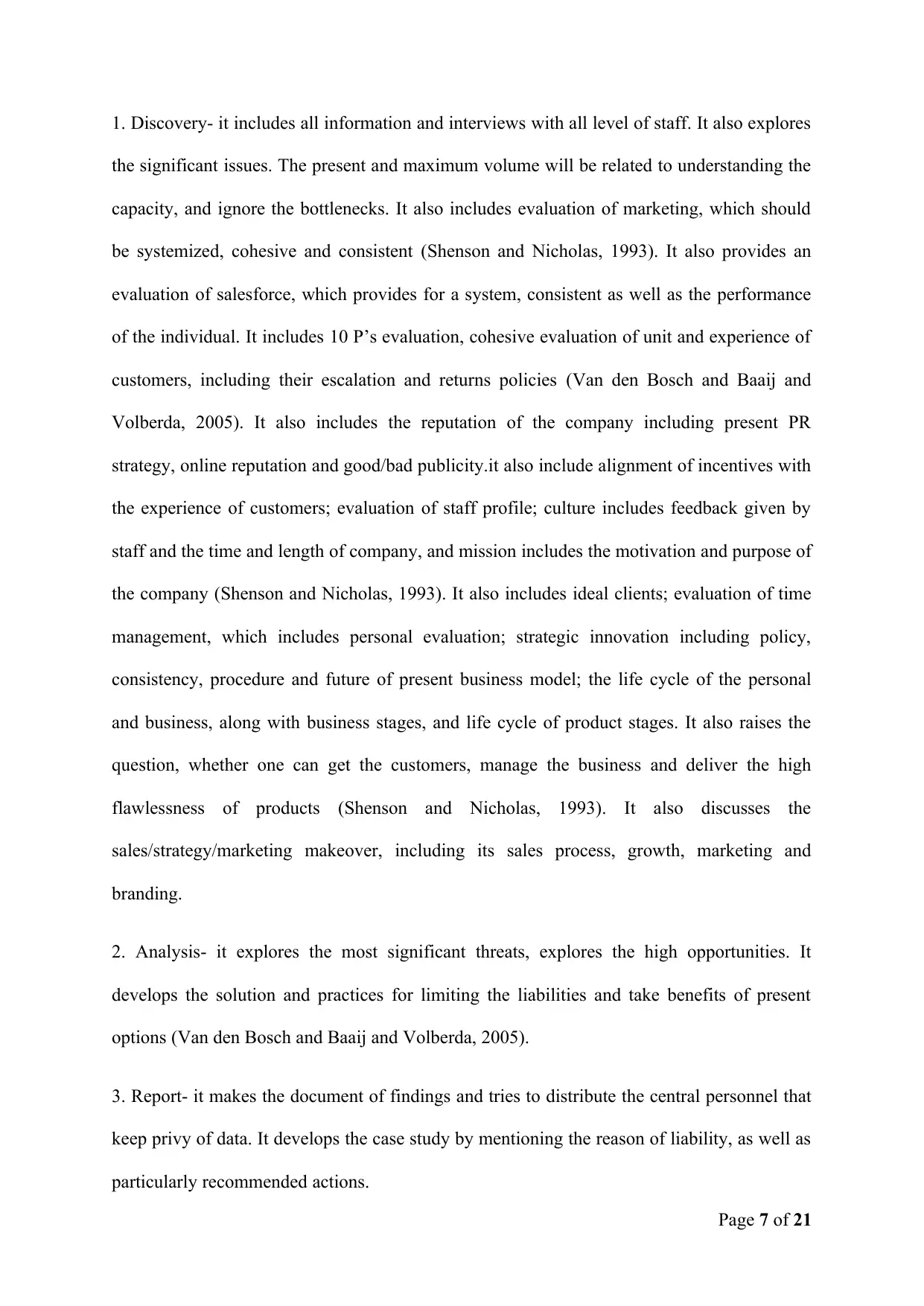
1. Discovery- it includes all information and interviews with all level of staff. It also explores
the significant issues. The present and maximum volume will be related to understanding the
capacity, and ignore the bottlenecks. It also includes evaluation of marketing, which should
be systemized, cohesive and consistent (Shenson and Nicholas, 1993). It also provides an
evaluation of salesforce, which provides for a system, consistent as well as the performance
of the individual. It includes 10 P’s evaluation, cohesive evaluation of unit and experience of
customers, including their escalation and returns policies (Van den Bosch and Baaij and
Volberda, 2005). It also includes the reputation of the company including present PR
strategy, online reputation and good/bad publicity.it also include alignment of incentives with
the experience of customers; evaluation of staff profile; culture includes feedback given by
staff and the time and length of company, and mission includes the motivation and purpose of
the company (Shenson and Nicholas, 1993). It also includes ideal clients; evaluation of time
management, which includes personal evaluation; strategic innovation including policy,
consistency, procedure and future of present business model; the life cycle of the personal
and business, along with business stages, and life cycle of product stages. It also raises the
question, whether one can get the customers, manage the business and deliver the high
flawlessness of products (Shenson and Nicholas, 1993). It also discusses the
sales/strategy/marketing makeover, including its sales process, growth, marketing and
branding.
2. Analysis- it explores the most significant threats, explores the high opportunities. It
develops the solution and practices for limiting the liabilities and take benefits of present
options (Van den Bosch and Baaij and Volberda, 2005).
3. Report- it makes the document of findings and tries to distribute the central personnel that
keep privy of data. It develops the case study by mentioning the reason of liability, as well as
particularly recommended actions.
Page 7 of 21
the significant issues. The present and maximum volume will be related to understanding the
capacity, and ignore the bottlenecks. It also includes evaluation of marketing, which should
be systemized, cohesive and consistent (Shenson and Nicholas, 1993). It also provides an
evaluation of salesforce, which provides for a system, consistent as well as the performance
of the individual. It includes 10 P’s evaluation, cohesive evaluation of unit and experience of
customers, including their escalation and returns policies (Van den Bosch and Baaij and
Volberda, 2005). It also includes the reputation of the company including present PR
strategy, online reputation and good/bad publicity.it also include alignment of incentives with
the experience of customers; evaluation of staff profile; culture includes feedback given by
staff and the time and length of company, and mission includes the motivation and purpose of
the company (Shenson and Nicholas, 1993). It also includes ideal clients; evaluation of time
management, which includes personal evaluation; strategic innovation including policy,
consistency, procedure and future of present business model; the life cycle of the personal
and business, along with business stages, and life cycle of product stages. It also raises the
question, whether one can get the customers, manage the business and deliver the high
flawlessness of products (Shenson and Nicholas, 1993). It also discusses the
sales/strategy/marketing makeover, including its sales process, growth, marketing and
branding.
2. Analysis- it explores the most significant threats, explores the high opportunities. It
develops the solution and practices for limiting the liabilities and take benefits of present
options (Van den Bosch and Baaij and Volberda, 2005).
3. Report- it makes the document of findings and tries to distribute the central personnel that
keep privy of data. It develops the case study by mentioning the reason of liability, as well as
particularly recommended actions.
Page 7 of 21
Paraphrase This Document
Need a fresh take? Get an instant paraphrase of this document with our AI Paraphraser
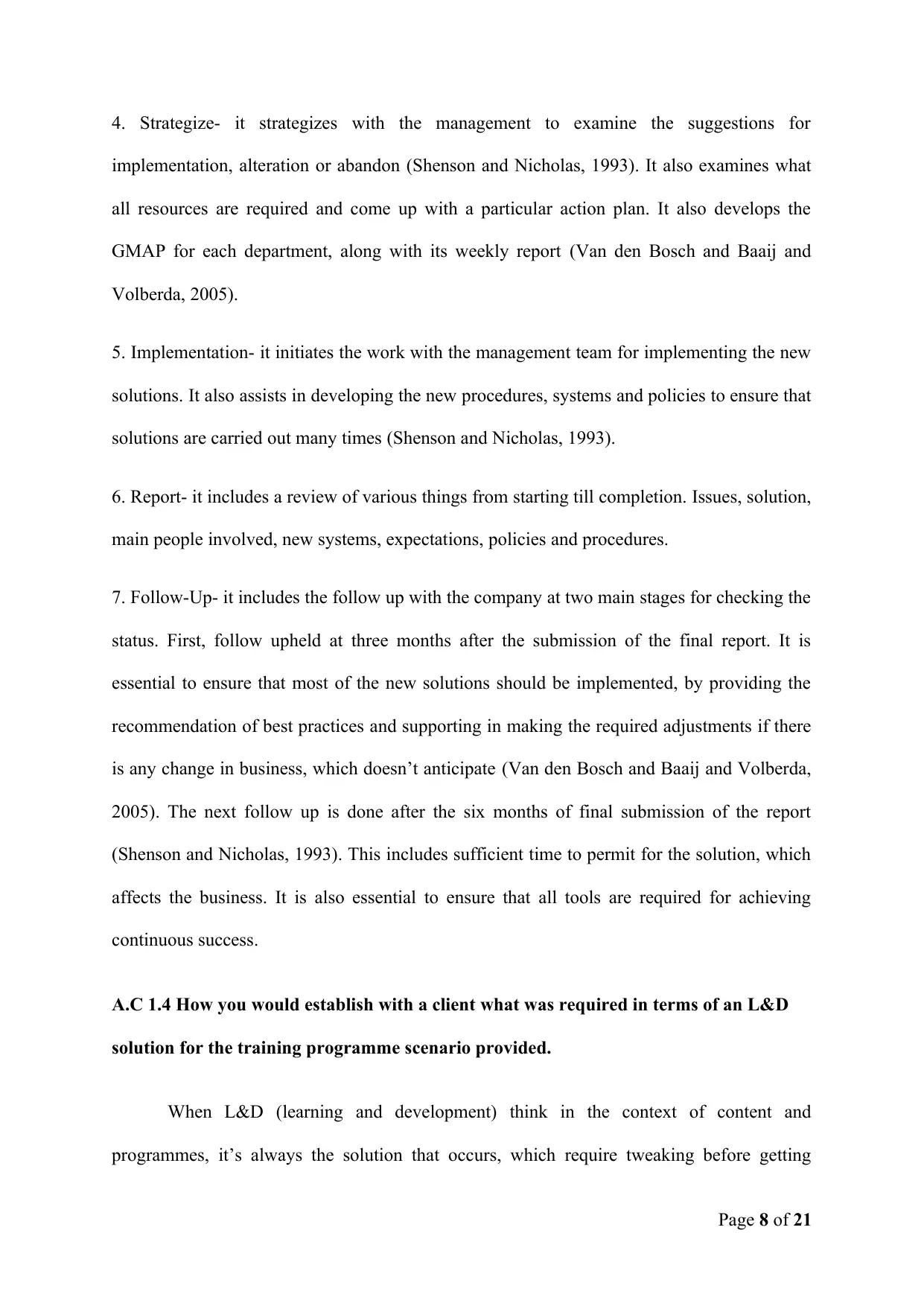
4. Strategize- it strategizes with the management to examine the suggestions for
implementation, alteration or abandon (Shenson and Nicholas, 1993). It also examines what
all resources are required and come up with a particular action plan. It also develops the
GMAP for each department, along with its weekly report (Van den Bosch and Baaij and
Volberda, 2005).
5. Implementation- it initiates the work with the management team for implementing the new
solutions. It also assists in developing the new procedures, systems and policies to ensure that
solutions are carried out many times (Shenson and Nicholas, 1993).
6. Report- it includes a review of various things from starting till completion. Issues, solution,
main people involved, new systems, expectations, policies and procedures.
7. Follow-Up- it includes the follow up with the company at two main stages for checking the
status. First, follow upheld at three months after the submission of the final report. It is
essential to ensure that most of the new solutions should be implemented, by providing the
recommendation of best practices and supporting in making the required adjustments if there
is any change in business, which doesn’t anticipate (Van den Bosch and Baaij and Volberda,
2005). The next follow up is done after the six months of final submission of the report
(Shenson and Nicholas, 1993). This includes sufficient time to permit for the solution, which
affects the business. It is also essential to ensure that all tools are required for achieving
continuous success.
A.C 1.4 How you would establish with a client what was required in terms of an L&D
solution for the training programme scenario provided.
When L&D (learning and development) think in the context of content and
programmes, it’s always the solution that occurs, which require tweaking before getting
Page 8 of 21
implementation, alteration or abandon (Shenson and Nicholas, 1993). It also examines what
all resources are required and come up with a particular action plan. It also develops the
GMAP for each department, along with its weekly report (Van den Bosch and Baaij and
Volberda, 2005).
5. Implementation- it initiates the work with the management team for implementing the new
solutions. It also assists in developing the new procedures, systems and policies to ensure that
solutions are carried out many times (Shenson and Nicholas, 1993).
6. Report- it includes a review of various things from starting till completion. Issues, solution,
main people involved, new systems, expectations, policies and procedures.
7. Follow-Up- it includes the follow up with the company at two main stages for checking the
status. First, follow upheld at three months after the submission of the final report. It is
essential to ensure that most of the new solutions should be implemented, by providing the
recommendation of best practices and supporting in making the required adjustments if there
is any change in business, which doesn’t anticipate (Van den Bosch and Baaij and Volberda,
2005). The next follow up is done after the six months of final submission of the report
(Shenson and Nicholas, 1993). This includes sufficient time to permit for the solution, which
affects the business. It is also essential to ensure that all tools are required for achieving
continuous success.
A.C 1.4 How you would establish with a client what was required in terms of an L&D
solution for the training programme scenario provided.
When L&D (learning and development) think in the context of content and
programmes, it’s always the solution that occurs, which require tweaking before getting
Page 8 of 21
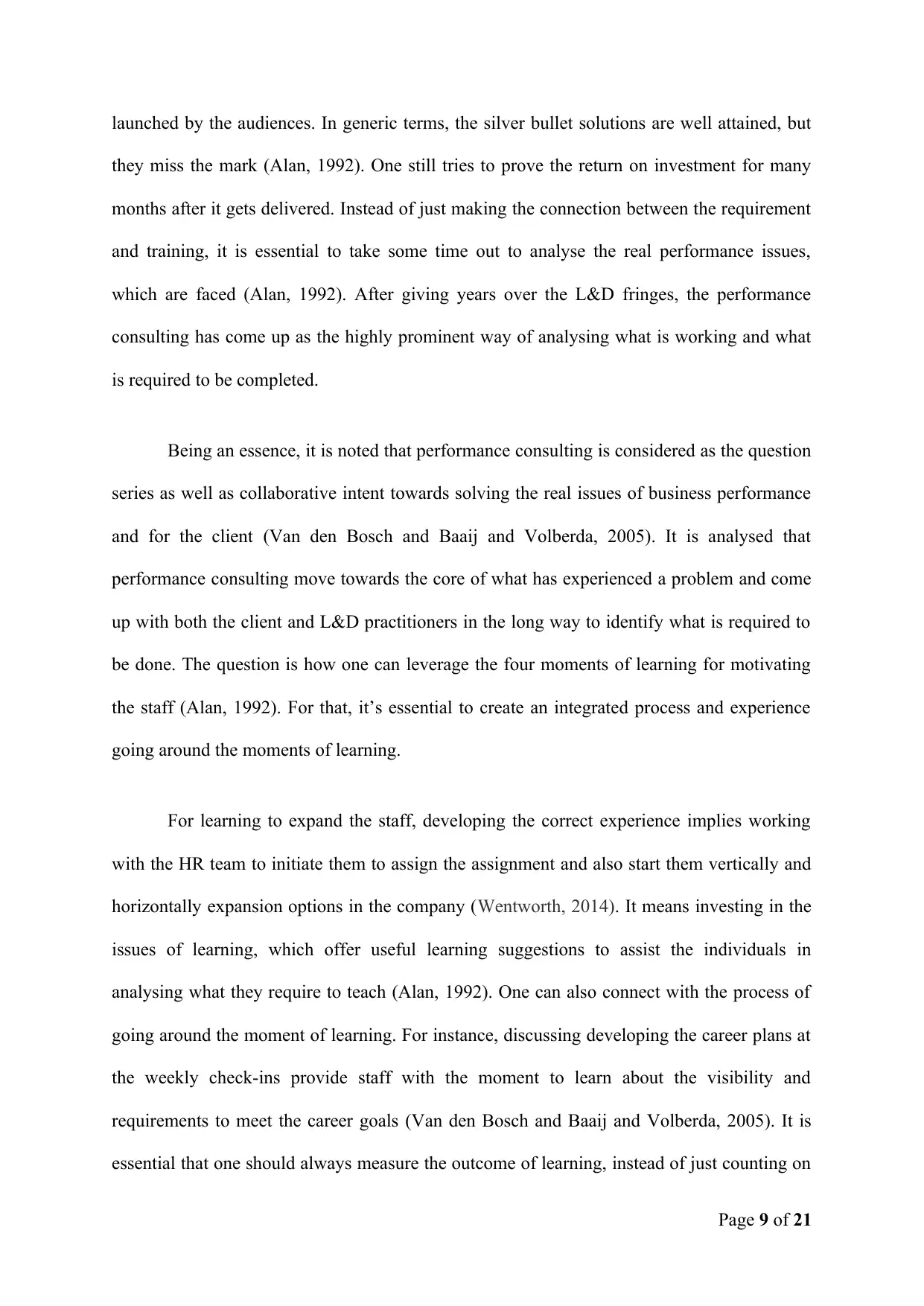
launched by the audiences. In generic terms, the silver bullet solutions are well attained, but
they miss the mark (Alan, 1992). One still tries to prove the return on investment for many
months after it gets delivered. Instead of just making the connection between the requirement
and training, it is essential to take some time out to analyse the real performance issues,
which are faced (Alan, 1992). After giving years over the L&D fringes, the performance
consulting has come up as the highly prominent way of analysing what is working and what
is required to be completed.
Being an essence, it is noted that performance consulting is considered as the question
series as well as collaborative intent towards solving the real issues of business performance
and for the client (Van den Bosch and Baaij and Volberda, 2005). It is analysed that
performance consulting move towards the core of what has experienced a problem and come
up with both the client and L&D practitioners in the long way to identify what is required to
be done. The question is how one can leverage the four moments of learning for motivating
the staff (Alan, 1992). For that, it’s essential to create an integrated process and experience
going around the moments of learning.
For learning to expand the staff, developing the correct experience implies working
with the HR team to initiate them to assign the assignment and also start them vertically and
horizontally expansion options in the company (Wentworth, 2014). It means investing in the
issues of learning, which offer useful learning suggestions to assist the individuals in
analysing what they require to teach (Alan, 1992). One can also connect with the process of
going around the moment of learning. For instance, discussing developing the career plans at
the weekly check-ins provide staff with the moment to learn about the visibility and
requirements to meet the career goals (Van den Bosch and Baaij and Volberda, 2005). It is
essential that one should always measure the outcome of learning, instead of just counting on
Page 9 of 21
they miss the mark (Alan, 1992). One still tries to prove the return on investment for many
months after it gets delivered. Instead of just making the connection between the requirement
and training, it is essential to take some time out to analyse the real performance issues,
which are faced (Alan, 1992). After giving years over the L&D fringes, the performance
consulting has come up as the highly prominent way of analysing what is working and what
is required to be completed.
Being an essence, it is noted that performance consulting is considered as the question
series as well as collaborative intent towards solving the real issues of business performance
and for the client (Van den Bosch and Baaij and Volberda, 2005). It is analysed that
performance consulting move towards the core of what has experienced a problem and come
up with both the client and L&D practitioners in the long way to identify what is required to
be done. The question is how one can leverage the four moments of learning for motivating
the staff (Alan, 1992). For that, it’s essential to create an integrated process and experience
going around the moments of learning.
For learning to expand the staff, developing the correct experience implies working
with the HR team to initiate them to assign the assignment and also start them vertically and
horizontally expansion options in the company (Wentworth, 2014). It means investing in the
issues of learning, which offer useful learning suggestions to assist the individuals in
analysing what they require to teach (Alan, 1992). One can also connect with the process of
going around the moment of learning. For instance, discussing developing the career plans at
the weekly check-ins provide staff with the moment to learn about the visibility and
requirements to meet the career goals (Van den Bosch and Baaij and Volberda, 2005). It is
essential that one should always measure the outcome of learning, instead of just counting on
Page 9 of 21
⊘ This is a preview!⊘
Do you want full access?
Subscribe today to unlock all pages.

Trusted by 1+ million students worldwide
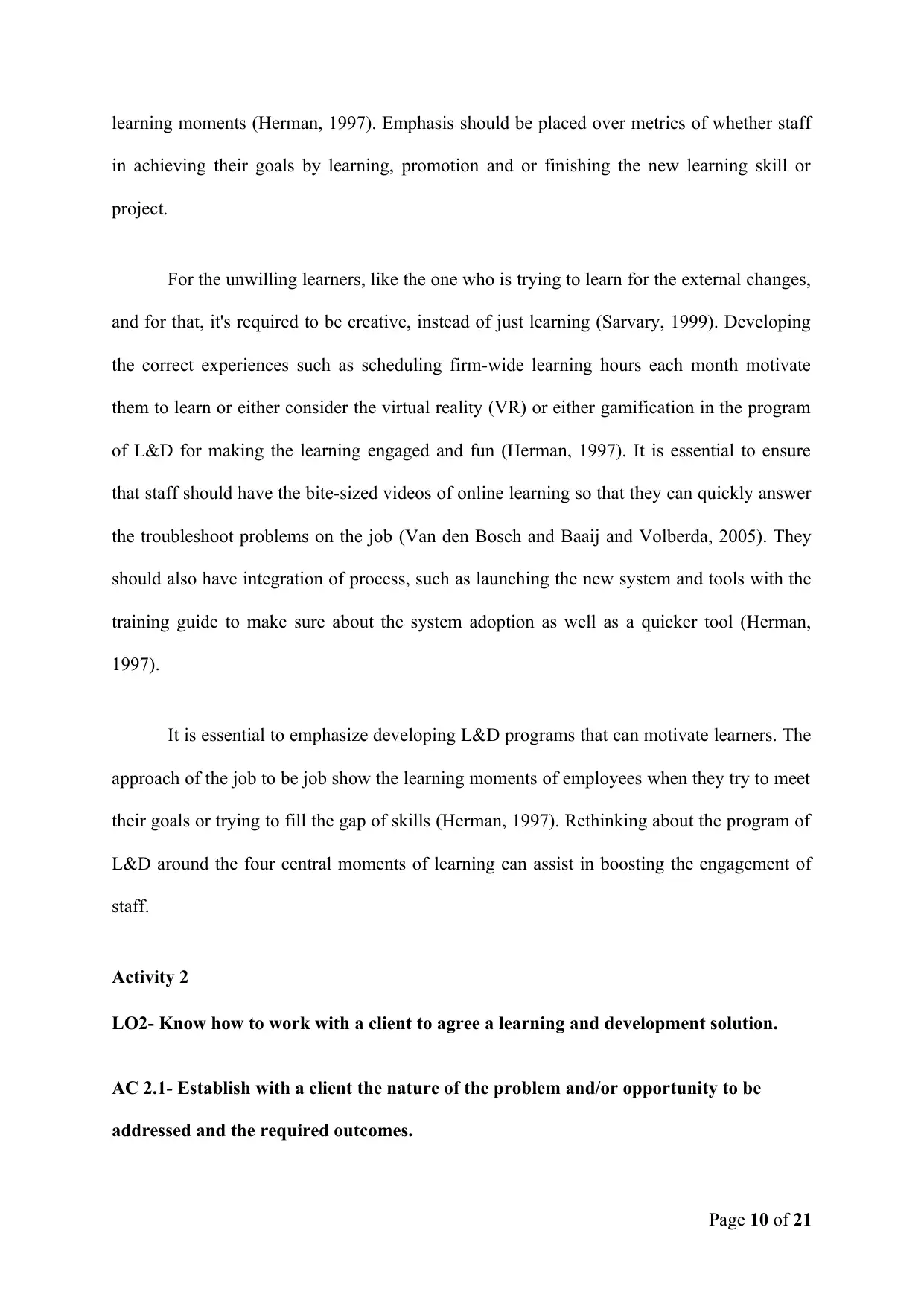
learning moments (Herman, 1997). Emphasis should be placed over metrics of whether staff
in achieving their goals by learning, promotion and or finishing the new learning skill or
project.
For the unwilling learners, like the one who is trying to learn for the external changes,
and for that, it's required to be creative, instead of just learning (Sarvary, 1999). Developing
the correct experiences such as scheduling firm-wide learning hours each month motivate
them to learn or either consider the virtual reality (VR) or either gamification in the program
of L&D for making the learning engaged and fun (Herman, 1997). It is essential to ensure
that staff should have the bite-sized videos of online learning so that they can quickly answer
the troubleshoot problems on the job (Van den Bosch and Baaij and Volberda, 2005). They
should also have integration of process, such as launching the new system and tools with the
training guide to make sure about the system adoption as well as a quicker tool (Herman,
1997).
It is essential to emphasize developing L&D programs that can motivate learners. The
approach of the job to be job show the learning moments of employees when they try to meet
their goals or trying to fill the gap of skills (Herman, 1997). Rethinking about the program of
L&D around the four central moments of learning can assist in boosting the engagement of
staff.
Activity 2
LO2- Know how to work with a client to agree a learning and development solution.
AC 2.1- Establish with a client the nature of the problem and/or opportunity to be
addressed and the required outcomes.
Page 10 of 21
in achieving their goals by learning, promotion and or finishing the new learning skill or
project.
For the unwilling learners, like the one who is trying to learn for the external changes,
and for that, it's required to be creative, instead of just learning (Sarvary, 1999). Developing
the correct experiences such as scheduling firm-wide learning hours each month motivate
them to learn or either consider the virtual reality (VR) or either gamification in the program
of L&D for making the learning engaged and fun (Herman, 1997). It is essential to ensure
that staff should have the bite-sized videos of online learning so that they can quickly answer
the troubleshoot problems on the job (Van den Bosch and Baaij and Volberda, 2005). They
should also have integration of process, such as launching the new system and tools with the
training guide to make sure about the system adoption as well as a quicker tool (Herman,
1997).
It is essential to emphasize developing L&D programs that can motivate learners. The
approach of the job to be job show the learning moments of employees when they try to meet
their goals or trying to fill the gap of skills (Herman, 1997). Rethinking about the program of
L&D around the four central moments of learning can assist in boosting the engagement of
staff.
Activity 2
LO2- Know how to work with a client to agree a learning and development solution.
AC 2.1- Establish with a client the nature of the problem and/or opportunity to be
addressed and the required outcomes.
Page 10 of 21
Paraphrase This Document
Need a fresh take? Get an instant paraphrase of this document with our AI Paraphraser
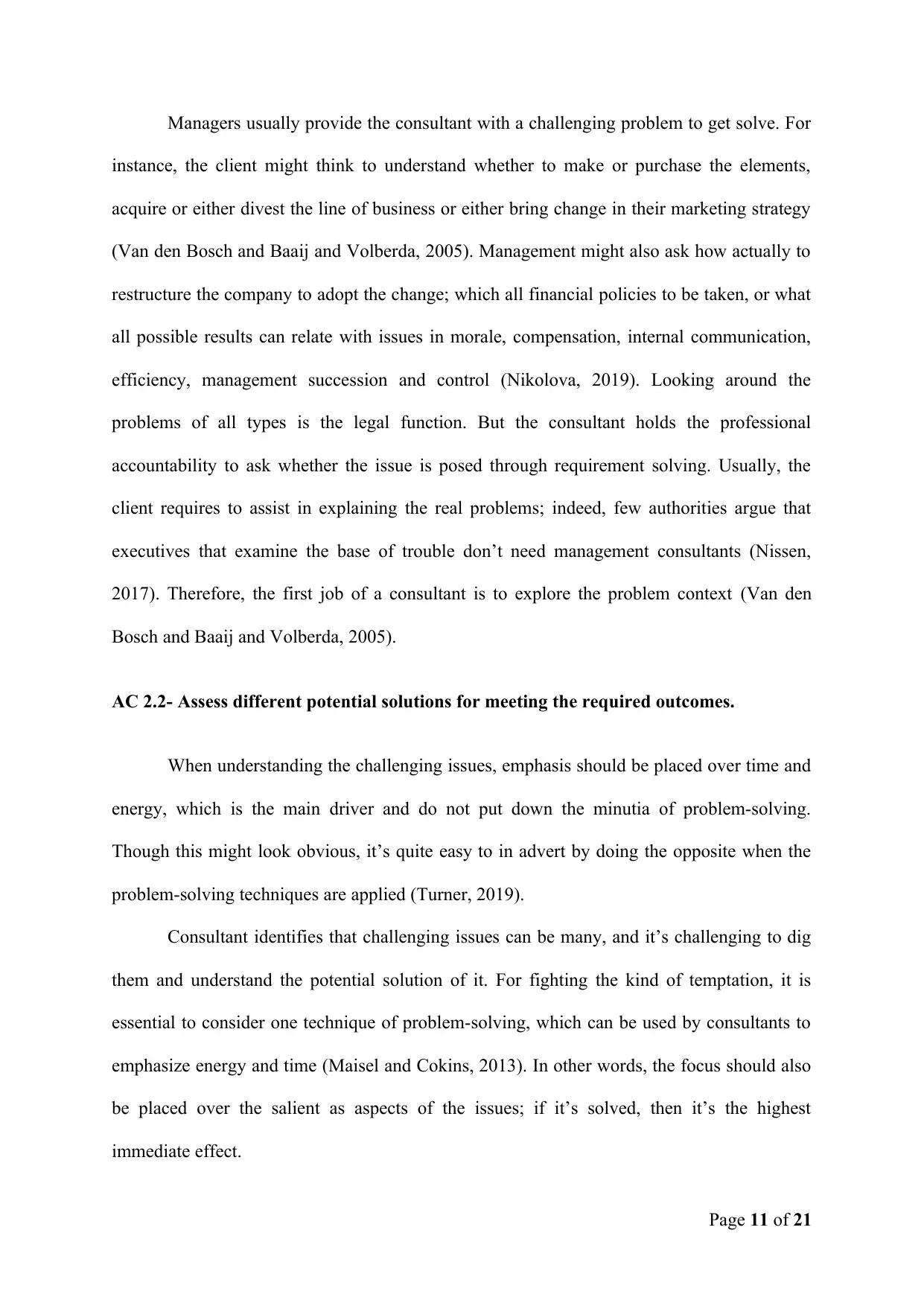
Managers usually provide the consultant with a challenging problem to get solve. For
instance, the client might think to understand whether to make or purchase the elements,
acquire or either divest the line of business or either bring change in their marketing strategy
(Van den Bosch and Baaij and Volberda, 2005). Management might also ask how actually to
restructure the company to adopt the change; which all financial policies to be taken, or what
all possible results can relate with issues in morale, compensation, internal communication,
efficiency, management succession and control (Nikolova, 2019). Looking around the
problems of all types is the legal function. But the consultant holds the professional
accountability to ask whether the issue is posed through requirement solving. Usually, the
client requires to assist in explaining the real problems; indeed, few authorities argue that
executives that examine the base of trouble don’t need management consultants (Nissen,
2017). Therefore, the first job of a consultant is to explore the problem context (Van den
Bosch and Baaij and Volberda, 2005).
AC 2.2- Assess different potential solutions for meeting the required outcomes.
When understanding the challenging issues, emphasis should be placed over time and
energy, which is the main driver and do not put down the minutia of problem-solving.
Though this might look obvious, it’s quite easy to in advert by doing the opposite when the
problem-solving techniques are applied (Turner, 2019).
Consultant identifies that challenging issues can be many, and it’s challenging to dig
them and understand the potential solution of it. For fighting the kind of temptation, it is
essential to consider one technique of problem-solving, which can be used by consultants to
emphasize energy and time (Maisel and Cokins, 2013). In other words, the focus should also
be placed over the salient as aspects of the issues; if it’s solved, then it’s the highest
immediate effect.
Page 11 of 21
instance, the client might think to understand whether to make or purchase the elements,
acquire or either divest the line of business or either bring change in their marketing strategy
(Van den Bosch and Baaij and Volberda, 2005). Management might also ask how actually to
restructure the company to adopt the change; which all financial policies to be taken, or what
all possible results can relate with issues in morale, compensation, internal communication,
efficiency, management succession and control (Nikolova, 2019). Looking around the
problems of all types is the legal function. But the consultant holds the professional
accountability to ask whether the issue is posed through requirement solving. Usually, the
client requires to assist in explaining the real problems; indeed, few authorities argue that
executives that examine the base of trouble don’t need management consultants (Nissen,
2017). Therefore, the first job of a consultant is to explore the problem context (Van den
Bosch and Baaij and Volberda, 2005).
AC 2.2- Assess different potential solutions for meeting the required outcomes.
When understanding the challenging issues, emphasis should be placed over time and
energy, which is the main driver and do not put down the minutia of problem-solving.
Though this might look obvious, it’s quite easy to in advert by doing the opposite when the
problem-solving techniques are applied (Turner, 2019).
Consultant identifies that challenging issues can be many, and it’s challenging to dig
them and understand the potential solution of it. For fighting the kind of temptation, it is
essential to consider one technique of problem-solving, which can be used by consultants to
emphasize energy and time (Maisel and Cokins, 2013). In other words, the focus should also
be placed over the salient as aspects of the issues; if it’s solved, then it’s the highest
immediate effect.
Page 11 of 21
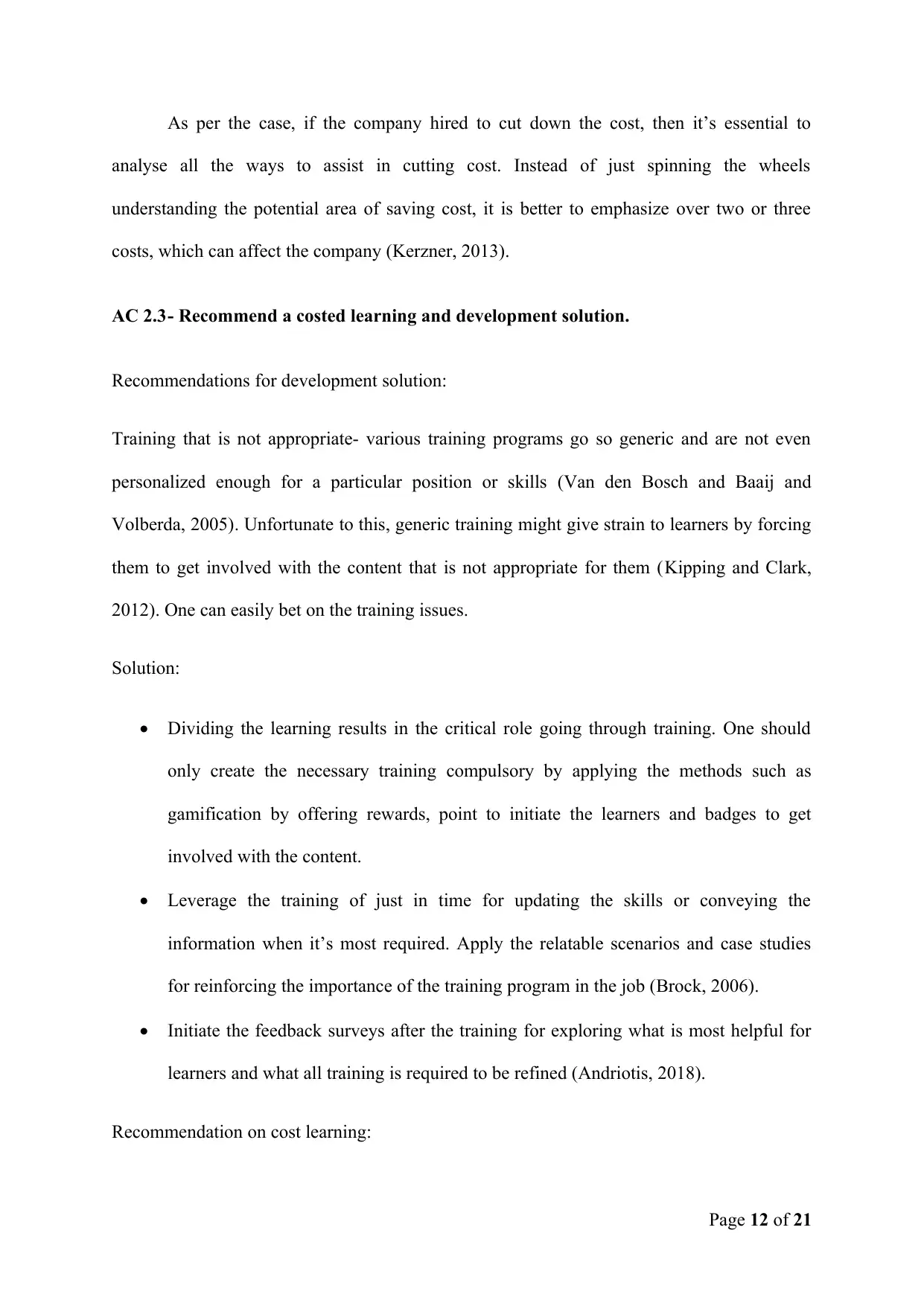
As per the case, if the company hired to cut down the cost, then it’s essential to
analyse all the ways to assist in cutting cost. Instead of just spinning the wheels
understanding the potential area of saving cost, it is better to emphasize over two or three
costs, which can affect the company (Kerzner, 2013).
AC 2.3- Recommend a costed learning and development solution.
Recommendations for development solution:
Training that is not appropriate- various training programs go so generic and are not even
personalized enough for a particular position or skills (Van den Bosch and Baaij and
Volberda, 2005). Unfortunate to this, generic training might give strain to learners by forcing
them to get involved with the content that is not appropriate for them (Kipping and Clark,
2012). One can easily bet on the training issues.
Solution:
Dividing the learning results in the critical role going through training. One should
only create the necessary training compulsory by applying the methods such as
gamification by offering rewards, point to initiate the learners and badges to get
involved with the content.
Leverage the training of just in time for updating the skills or conveying the
information when it’s most required. Apply the relatable scenarios and case studies
for reinforcing the importance of the training program in the job (Brock, 2006).
Initiate the feedback surveys after the training for exploring what is most helpful for
learners and what all training is required to be refined (Andriotis, 2018).
Recommendation on cost learning:
Page 12 of 21
analyse all the ways to assist in cutting cost. Instead of just spinning the wheels
understanding the potential area of saving cost, it is better to emphasize over two or three
costs, which can affect the company (Kerzner, 2013).
AC 2.3- Recommend a costed learning and development solution.
Recommendations for development solution:
Training that is not appropriate- various training programs go so generic and are not even
personalized enough for a particular position or skills (Van den Bosch and Baaij and
Volberda, 2005). Unfortunate to this, generic training might give strain to learners by forcing
them to get involved with the content that is not appropriate for them (Kipping and Clark,
2012). One can easily bet on the training issues.
Solution:
Dividing the learning results in the critical role going through training. One should
only create the necessary training compulsory by applying the methods such as
gamification by offering rewards, point to initiate the learners and badges to get
involved with the content.
Leverage the training of just in time for updating the skills or conveying the
information when it’s most required. Apply the relatable scenarios and case studies
for reinforcing the importance of the training program in the job (Brock, 2006).
Initiate the feedback surveys after the training for exploring what is most helpful for
learners and what all training is required to be refined (Andriotis, 2018).
Recommendation on cost learning:
Page 12 of 21
⊘ This is a preview!⊘
Do you want full access?
Subscribe today to unlock all pages.

Trusted by 1+ million students worldwide
1 out of 21
Your All-in-One AI-Powered Toolkit for Academic Success.
+13062052269
info@desklib.com
Available 24*7 on WhatsApp / Email
![[object Object]](/_next/static/media/star-bottom.7253800d.svg)
Unlock your academic potential
Copyright © 2020–2025 A2Z Services. All Rights Reserved. Developed and managed by ZUCOL.
